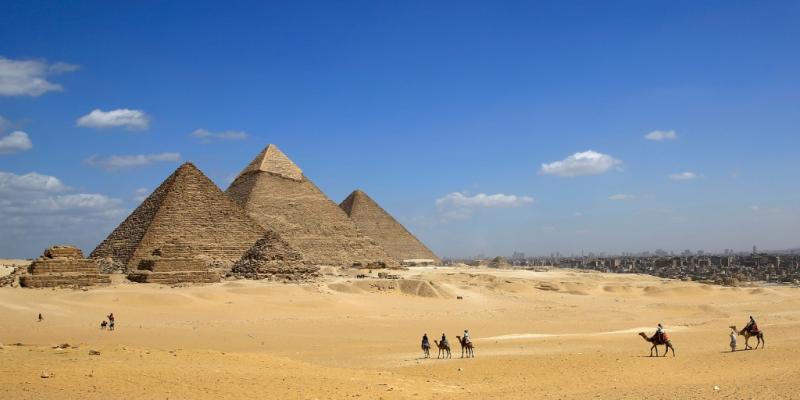Egyptian pyramids, including in Giza, sat along branch of the Nile, study says



The pyramids in and around Giza have presented a fascinating puzzle for millennia.
How did ancient Egyptians move limestone blocks, some weighing more than a ton, without using wheels? Why were these burial structures seemingly built in the remote and inhospitable desert?
New research — published Thursday in the journal Communications Earth & Environment — offers a possible answer, providing new evidence that an extinct branch of the Nile River once weaved through the landscape in a much wetter climate. Dozens of Egyptian pyramids across a 40-mile-long range rimmed the waterway, the study says, including the best-known complex in Giza.
The waterway allowed workers to transport stone and other materials to build the monuments, according to the study. Raised causeways stretched out horizontally, connecting the pyramids to river ports along the Nile's bank.
Drought, in combination with seismic activity that tilted the landscape, most likely caused the river to dry up over time and ultimately fill with silt, removing most traces of it.
The research team based its conclusions on data from satellites that send radar waves to penetrate the Earth's surface and detect hidden features. It also relied on sediment cores and maps from 1911 to uncover and trace the imprint of the ancient waterway. Such tools are helping environmental scientists map the ancient Nile, which is now covered by desert sand and agricultural fields.
Experts have suspected for decades that boats transported workers and tools to build the pyramids. Some past research has put forward hypotheses similar to the new study; the new findings solidify the theory and map a much broader area.
"The mapping of the Nile's ancient channel system has been fragmented and isolated," an author of the new study, Eman Ghoneim, a professor of earth and ocean sciences at the University of North Carolina Wilmington, wrote in an email. "Ancient Egyptians were using waterways for transportation more often than we thought."
 The Red Pyramid at the Dahshur necropolis.Eman Ghoneim
The Red Pyramid at the Dahshur necropolis.Eman Ghoneim
The study looks at 31 pyramids between Lisht, a village south of Cairo, and Giza. They were constructed over roughly 1,000 years, beginning about 4,700 years ago. The pyramid complexes contained tombs for Egyptian royals. High officials were often buried nearby.
Some of the granite blocks used to construct them were sourced from locations hundreds of miles south of their sites. In some cases, the blocks could be "mammoth," weighing several tons, said Peter Der Manuelian, a professor of Egyptology at Harvard University and the director of the Harvard Museum's Museum of the Ancient East.
Manuelian, who was not involved in the new study, said wheels were not used to move the large blocks, which is one reason researchers have long suspected the Egyptians moved materials by water.
"It's all sledges," he said. "Water helps an awful lot."
In the past, researchers have posited that the Egyptians might have carved canals to the pyramid sites.
"Canals and waterway systems have been in the consciousness for decades now," Manuelian said. But newer theories suggest that the Nile was closer to the pyramids than researchers once thought, he added, and new tools can provide some proof.
"Archaeology has gotten more scientific, and you have ground-penetrating radar and satellite imagery," he said.
He added that the new study helps improve maps of ancient Egypt.
 The water course of the Ahramat Branch of the Nile borders a large number of pyramids in Egypt, dating from the Old Kingdom to the Second Intermediate Period.Eman Ghoneim
The water course of the Ahramat Branch of the Nile borders a large number of pyramids in Egypt, dating from the Old Kingdom to the Second Intermediate Period.Eman Ghoneim
The findings suggest that millennia ago, the Egyptian climate was wetter overall and the Nile carried a higher volume of water. It separated into multiple branches, one of which — the researchers call it the Ahramat Branch — was about 40 miles long.
The locations of the pyramid complexes included in the study correspond in time with estimates of the river branch's location, according to the authors, as water levels ebbed and flowed over centuries.
In addition, several pyramid temples and causeways appear to line up horizontally with the ancient riverbed, which suggests that they were directly connected to the river and most likely used to transport building materials.
The study builds on research from 2022, which used ancient evidence of pollen grains from marsh species to suggest that a waterway once cut through the present-day desert.
Hader Sheisha, an author of that study who is now an associate professor in the natural history department at the University Museum of Bergen, said the new findings add much-needed evidence to bolster and expand the theory.
"The new study, in concordance to our study, shows that when the pyramids were built, the landscape was different from that we see today and shows how the ancient Egyptians could interact with their physical world and harness their environment to achieve their immense projects," Sheisha said in an email.
 The Step Pyramid of Djoser.Eman Ghoneim
The Step Pyramid of Djoser.Eman Ghoneim
Ghoneim and her team explain in the study that the Ahramat Branch shifted eastward over time, a process that might have been propelled by drought about 4,050 years ago. Then it gradually dissolved, only to be covered in silt.
She said they plan to expand their map and work to detect additional buried branches of the Nile floodplain. Determining the outline and shape of the ancient river branch could help researchers locate the remains of settlements or undiscovered sites before the areas get built over.
Manuelian said that today, "housing almost goes right up to the edge of the Giza plateau. Egypt is a vast outdoor museum, and there's more to be discovered."







Makes sense, why work harder than necessary